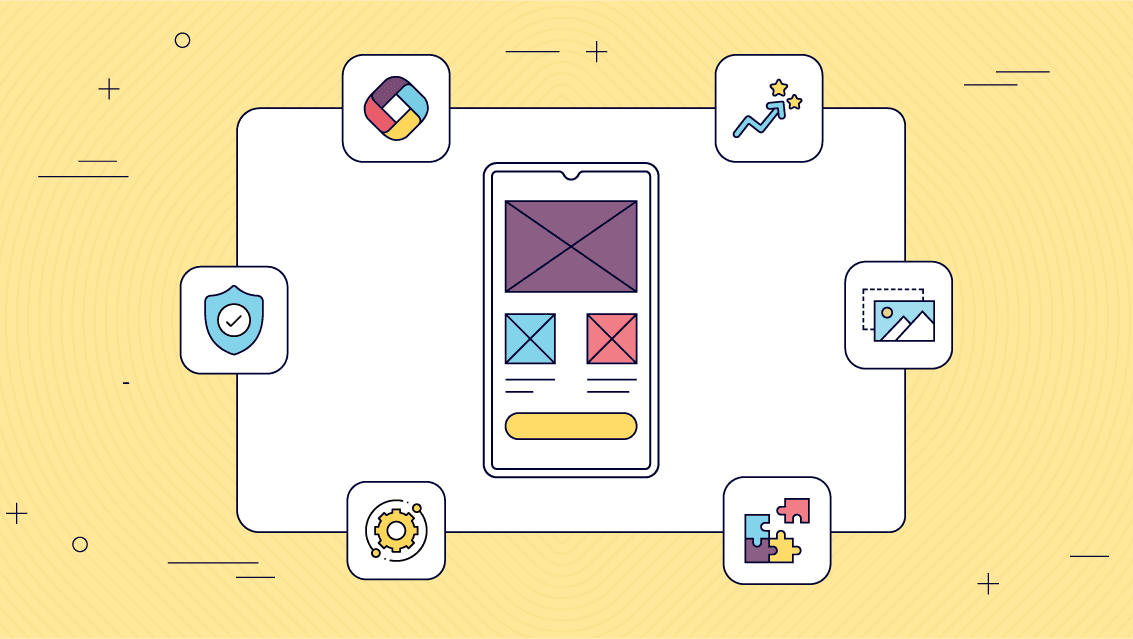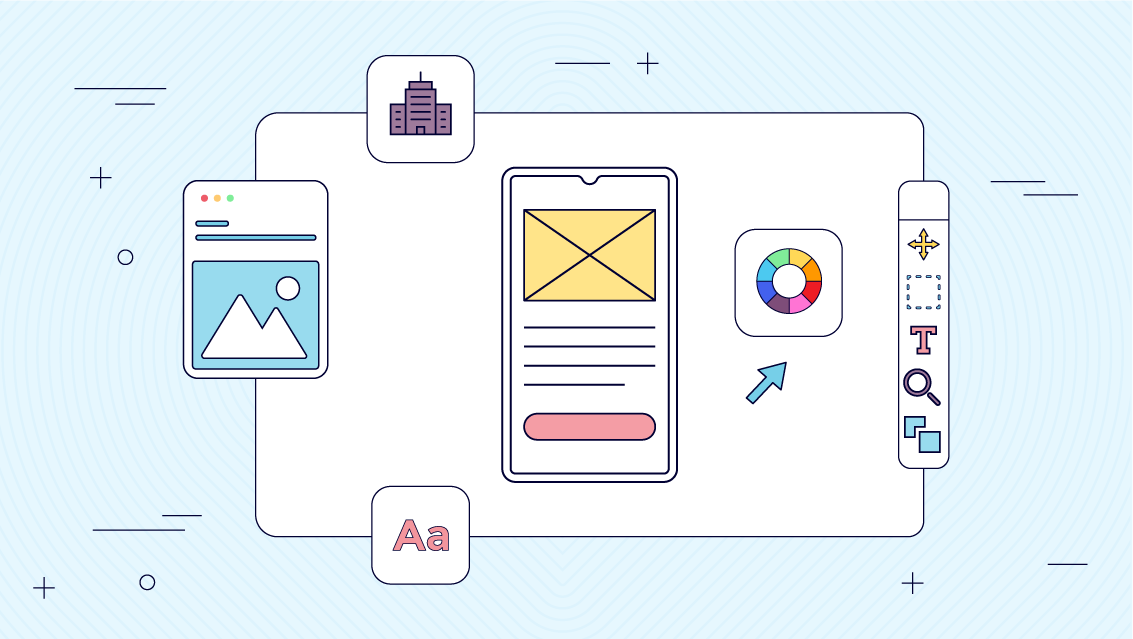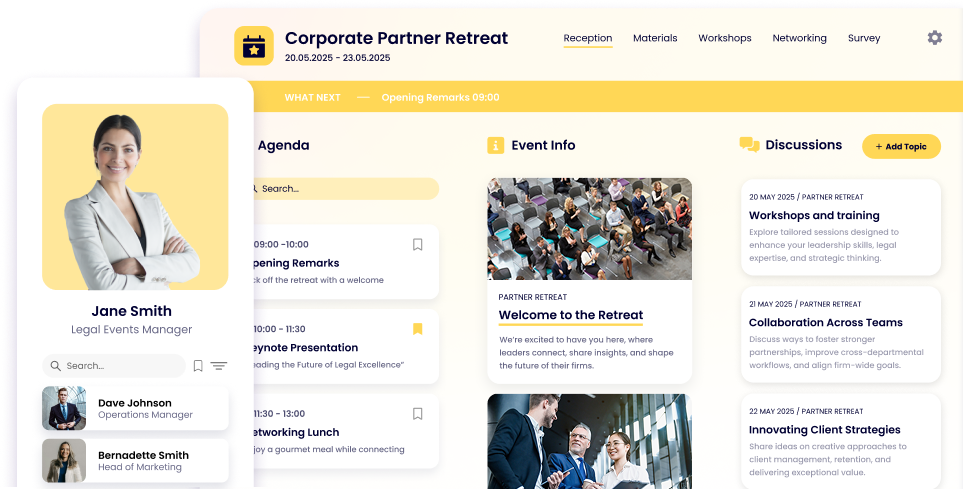How to Build a Custom App Without Any Coding (6 Steps)

Niamh Conneely | Marketing Executive
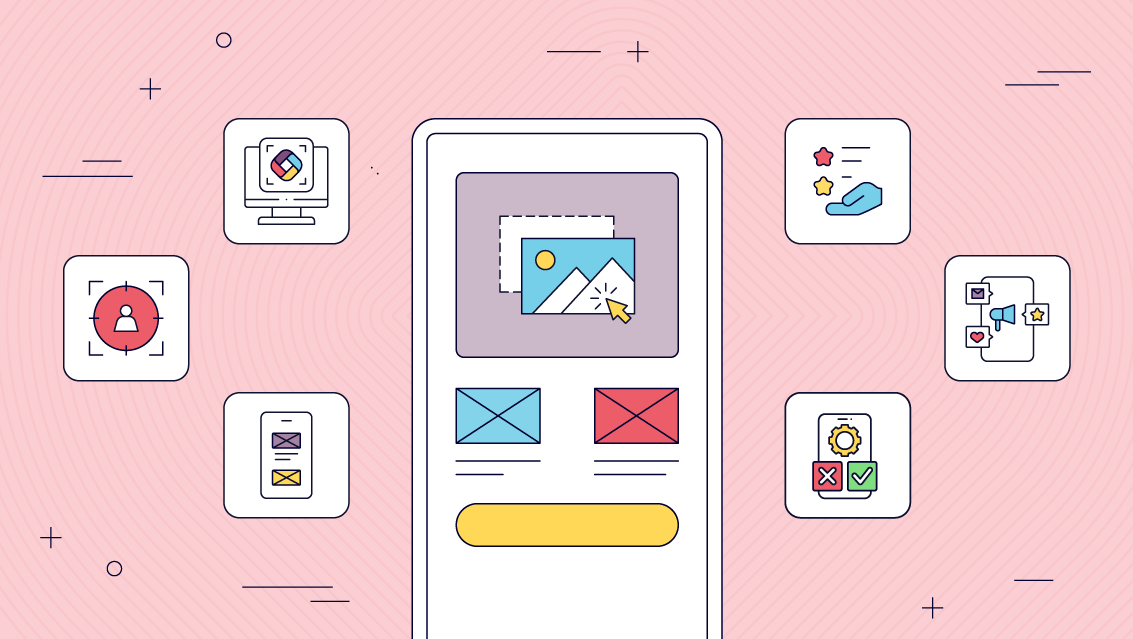
In this guide, we’ll take you through a step-by-step process to build your custom app using no-code platforms, and we’ll debunk the myth that app development requires complex coding skills. Let’s dive in and explore the world of no-code app creation.
What is custom app development?
Custom app development involves creating applications tailored to specific business needs, often delivering unique features that standard apps lack. This process used to be associated with coding and development skills, but no-code platforms have revolutionized the landscape, allowing you to bring your app ideas to life without coding.
6 Steps for creating and building your custom apps
1.Determine the Purpose of Your App: Aligning Objectives with User Needs
Before starting on your app-building journey, it’s important to have a clear vision of your app’s purpose and its intended outcomes. This step will help you set the direction for the entire project.
Defining your objectives
Start by pinpointing what you want to achieve with your app. Are you aiming to streamline internal processes, enhance customer engagement, offer a unique service, or solve a specific problem? These objectives will guide your app’s design, features, and functionalities.
Understanding your target audience’s needs
Your app’s success hinges on its ability to fulfill the needs of its users. Research and analyze your target audience – their preferences, pain points, and behaviors. Creating user personas can help you visualize your ideal users and tailor your app’s features to address their requirements.
Highlighting the importance of market research
Market research is the compass that directs your app development journey. Analyze your competitors, identify gaps in the market, and gain insights into user expectations. This knowledge will help you position your app uniquely and offer features that stand out.
2.Choose the Right No-Code Platform: Navigating Your Options
As you begin your no-code app-building journey, it’s crucial to choose the platform that aligns best with your project’s scope and goals. Discover the list created by Fliplet on the top 10 best mobile application development platforms for your organization in 2023.
Comparing three popular no-code platforms
Fliplet

Benefits
- Perfect for enterprise: Fliplet caters to enterprise-level needs, making it suitable for building custom apps for internal teams or clients.
- Pre-built solutions: 17 pre-built solutions help to kick-start your app development process, and speed up the development process.
- Easy to use: Like most no-code platforms, it is easy to change or update an application that’s built with Bubble. You do not even need any technical skills to do this as you can drag and drop features into your app to make it easy for anyone to build an app.
- Security: Fliplet has an ISO 27001 certification, and ensures that all required security protocols are in place and up to date. As well as this, we offer enterprise grade security, fully encrypted and SSO integration.
- White label: Make the app your own by quickly and easily customizing the app to fit with your brand’s logo, colors, fonts, and style.
- Support: We offer great support such as support articles, Fliplet community, customer support team, a chat feature on the website where you can ask questions.
- Flexible: Fliplet has an array of features that you can use for your app. As well as this, Fliplet enables you to use code if you like to make it more personalized.
Key Features
- Cross-platform compatibility (iOS, Android, web)
- Integration with enterprise systems like SharePoint, Salesforce, Google drive, Microsoft and more
- Apps Available Offline
- Mobile and Web Apps
- Analytics
- Optimized for all devices
- Collaboration tools for team-based app building
Fliplet Solutions
- Learning (Want to start building your learning app? Read this blog to see how you can build one on a budget)
- Directory (Check out 15 HR apps that will change the way you work)
- Marketing
- Innovation/idea management
- Approval workflow
- Portal app
- Sales Enablement
- Communications (Take a look at this blog where we compared the top 10 community apps to engage and monetize your community or you can check out the 15 best team communication apps of 2023)
- Data capture
- Emergency Management (Take a look at the 5 steps to take to prepare for a dawn raid)
- Events (To compare our Event solution to other solutions read the 25 best mobile event apps you need in 2023)
- Food ordering
- Multilingual
- Remote and office management
- Task management
- Reporting App
- Blank solution to build from scratch
Each Fliplet solution has unique features tailored to that solution to make it perfect for you. You can customize the solution to suit your needs and select the features right for you. Check out more Fliplet features.
Limitations
At first glance Fliplet can appear to be complicated however, users do find it quick and easy to pick up
Bubble
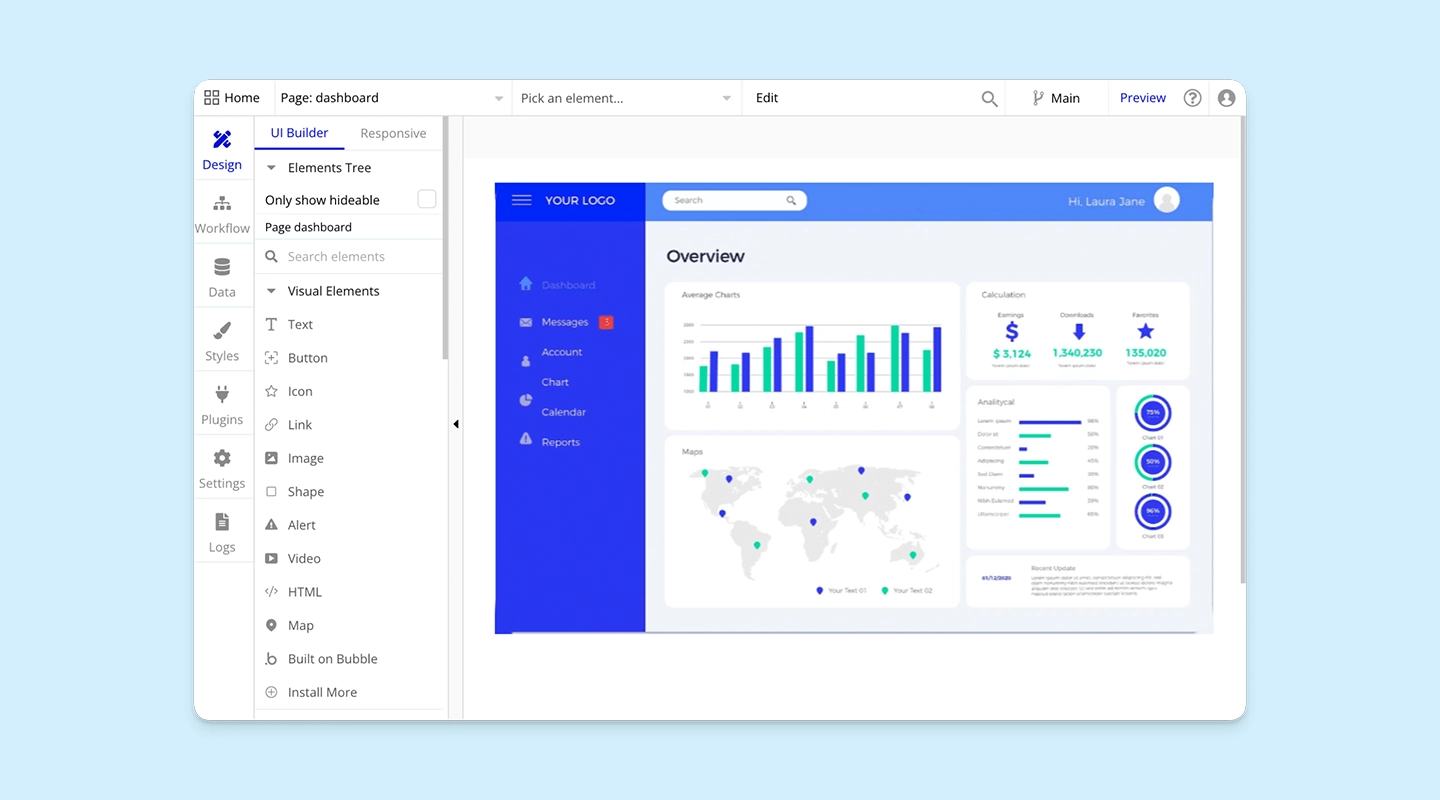
Benefits
- Selection of features: It provides a library of plugins and integrations, enabling you to add advanced functionalities to your app.
- Easy to use: You don’t need to know coding to use this platform.
Key Features
- Drag-and-drop interface for creating UI/UX.
- Robust database integration and data workflows.
- Built-in user authentication and access control.
- Interactive elements such as animations, conditional workflows, and responsive design.
Limitations
Bubble isn’t built for everything – you need to have a clear idea of what you want to create in order to determine if this is the right no-code tool for you. Also, Bubble’s learning curve can be steep for users who are new to no-code development. While it offers great flexibility, building complex logic and workflows might require a deeper understanding of the platform.
Adalo
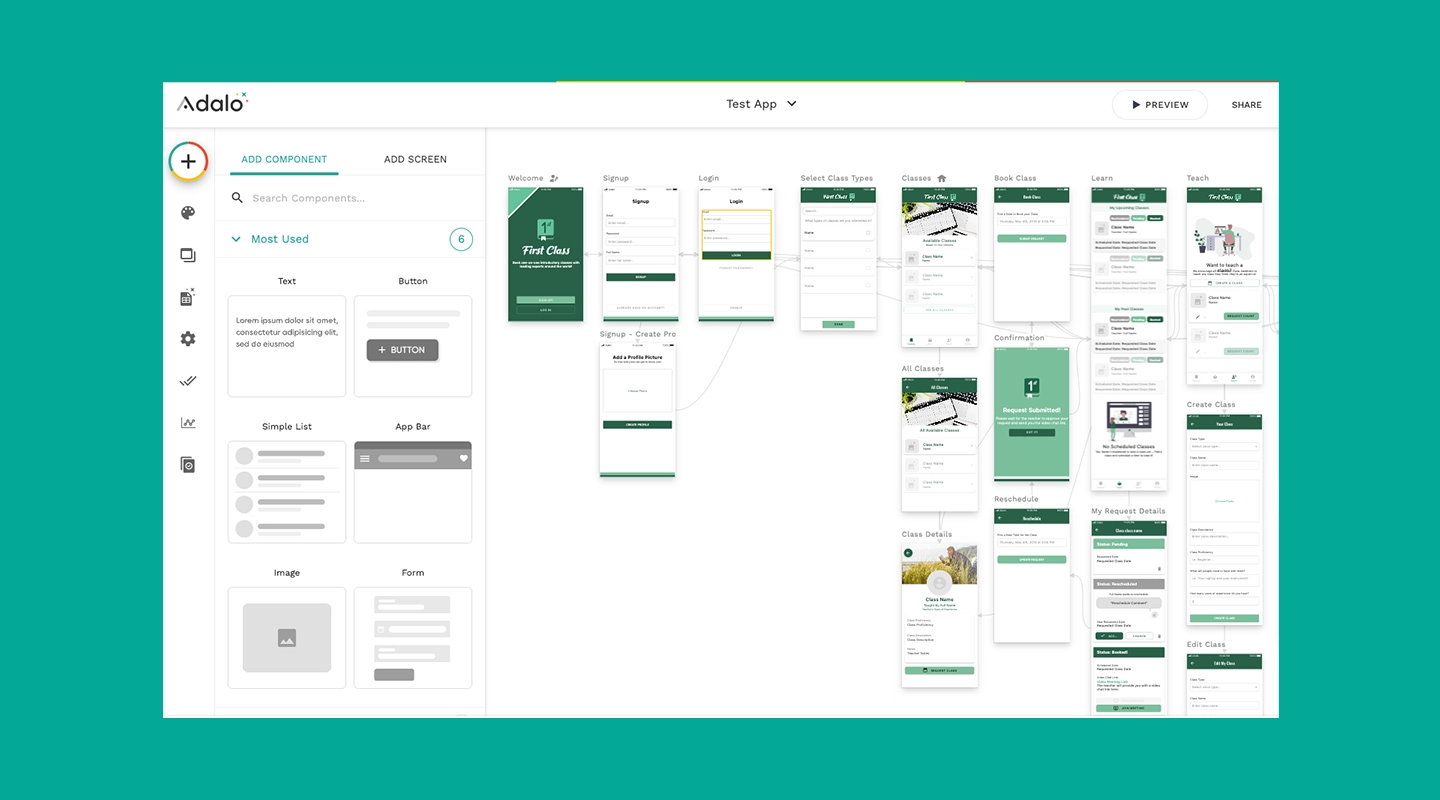
Benefits
- Mobile-centric: Adalo specializes in creating mobile apps, allowing you to design and deploy apps for iOS and Android.
- Simplicity: Its intuitive interface is user friendly making it a good choice for those new to app development.
Key Features
- Drag-and-drop components for building app screens.
- Custom actions and logic using visual workflows.
- Native mobile app capabilities such as camera access and GPS integration.
- User authentication and registration features.
Limitations
Adalo’s focus on mobile app development might limit its suitability for creating complex web applications. While it offers simplicity, more advanced users might find its features somewhat limited compared to other platforms.
Each of these platforms offers a distinct set of benefits, features, and limitations. Your choice should align with your project’s requirements, your technical comfort level, and your desired end result. Evaluate these platforms based on your specific needs to ensure that your app-building journey is both successful and fulfilling. We researched The Top 10 Best App Builders to Create a Mobile App, check it out.
Selecting the right no-code platform for you
To make an informed decision, evaluate potential platforms based on several critical criteria:
- Scalability: Consider the long-term potential of the platform. Will it support your app’s growth as you add more features and users?
- Features: Review the platform’s feature set. Does it include the functionalities your app requires, such as user authentication, database integration, e-commerce capabilities, and more? Discover the 16 Top Features of a Successful Mobile App.
- Pricing structure: Understand the pricing models offered by different platforms. Some platforms offer free plans with limited features, while others provide more comprehensive packages at a cost. Choose the pricing structure that aligns with your budget and app’s complexity.
- Integrations: Check if the platform offers integrations with other tools and services you might need. Seamless integration with CRM systems, payment gateways, or third-party APIs can significantly enhance your app’s capabilities.
- Ease of use: No-code platforms are designed to simplify app development, but some may have a steeper learning curve than others. Choose a platform that resonates with your level of technical expertise and provides a user-friendly interface.
- Flexibility: While no-code platforms offer pre-designed templates, consider whether the platform allows you to customize these templates to match your app’s branding and unique requirements.
- Support and community: Look for platforms with an active user community and robust customer support. Access to resources, tutorials, and a community forum can be invaluable as you navigate the app-building process.
3.Design the User Interface (UI)
An aesthetically appealing and user-friendly UI is essential for capturing and retaining users’ attention. Consider the following aspects when designing your app’s UI:
- Intuitive layout: Organize your app’s layout in a logical and intuitive manner to guide users through the app effortlessly.
- Color schemes: Choose a color palette that aligns with your brand and evokes the desired emotions in users.
- User experience (UX): Prioritize smooth navigation, clear call-to-action buttons, and an overall seamless experience.
- Templates vs. custom design: Decide whether to start with pre-designed templates or create a unique design from scratch.
Designing Your First App UI on Fliplet
4.Integrate Features and Functionalities
Exploring common features and functionalities in no-code app development
No-code app development platforms empower you to create applications with a wide range of features that can cater to various needs. Let’s delve into some of the common features and functionalities that you can easily integrate into your custom app:
User Authentication
User authentication is a fundamental feature that ensures the security and privacy of your app. It allows users to create accounts, log in securely, and access personalized content. With no-code platforms, you can implement user authentication easily, enabling users to register using their email addresses or social media accounts. This feature gives a sense of trust and connection with your app, promoting user engagement and data protection.
Database Integration
Database integration is crucial for apps that store and manage user data, product information, or any other dynamic content. No-code platforms often offer integrations with third-party tools like Zapier or Microsoft Power Apps to connect your app with external databases. This allows you to automate data syncing, streamline information flow, and provide real-time updates to users. Database integration enhances your app’s functionality and ensures accurate and up-to-date information.
E-commerce functions
For apps focused on buying and selling products or services, e-commerce functionalities are essential. No-code platforms offer tools to set up online stores, add product catalogs, facilitate secure payments, and manage order processing. This feature enables you to create a seamless shopping experience for your users, generating revenue and increasing customer satisfaction.
Reports and analytics
No-code platforms often provide built-in reporting and analytics tools that allow you to track various metrics related to app usage and performance. You can measure metrics such as user engagement, session duration, popular features, and more. These insights help you understand how users interact with your app, identify areas for improvement, and make data-driven decisions to enhance user experience. Measuring and analyzing app metrics provides valuable insights into user behavior, preferences, and pain points. This information enables you to refine your app’s features, enhance usability, and tailor your offerings to user needs.
How to drag-and-drop or use built-in modules for adding functionalities
Drag and drop
One of the best features of no-code platforms is their ability to simplify complex processes. Most platforms offer a range of pre-built features that can be easily integrated into your app with a simple drag-and-drop action. These modules are designed to handle specific functionalities, such as forms, maps, calendars, notifications, and more. By leveraging these modules, you can add sophisticated features to your app without the need for coding.
For instance, if you want to incorporate user authentication, you can simply drag and drop an authentication module onto your app’s interface. This module will come with pre-configured settings that you can customize according to your app’s requirements. Similarly, for database integration, you can choose a database module, link it to your app’s interface, and define how data should be stored and retrieved.
Read our Ultimate Guide: How to scale mobile enterprise app development without coding or IT resources
Utilizing built-in functionality
In addition to drag-and-drop modules, many no-code platforms also provide built-in functionality components. These components are often customizable and can be easily configured to suit your app’s needs. For example, if you want to add a search feature to your app, you can use a built-in search component and define which data it should search through.
By making use of these intuitive tools, you can efficiently incorporate features that enhance your app’s value proposition. Remember that the goal is to create a seamless and user-friendly experience, and no-code platforms equip you with the tools to achieve just that. As you progress through this step, you’ll find that the ability to integrate functionalities effortlessly is a hallmark of the power of no-code app development.
Incorporating Essential Features in your No-Code App with Fliplet
5.Test your app
Once you’ve crafted your no-code app with its integrated features and functionalities, the next crucial step is to thoroughly test it before launching it to the world. Robust testing is essential to ensure your app’s usability and functionality meet user expectations and deliver a seamless experience. Here’s why testing is vital and how you can engage testers effectively:
Importance of iterative testing
Iterative testing involves a systematic process of identifying and fixing issues in your app’s usability and functionality. Testing in this way allows you to catch bugs, glitches, or design flaws early on, preventing them from negatively affecting the user experience. It’s a way to fine-tune your app and ensure that it operates smoothly across different devices, browsers, and scenarios. By addressing issues iteratively, you enhance user satisfaction and minimize negative feedback upon launch.
Engaging friends, family, or beta testers
Engaging a diverse group of individuals, such as friends, family members, or beta testers, is invaluable for gathering unbiased feedback. These individuals represent potential users who can offer fresh perspectives and identify usability issues that you might overlook. Their insights can help you identify aspects of your app that are confusing, cumbersome, or require improvement. Encourage them to interact with your app as a typical user would, and ask for feedback on navigation, design, functionality, and overall user experience.
How to get effective feedback
Establish a clear feedback loop with your testers to capture their observations and suggestions. Provide them with specific tasks to perform within your app and encourage them to share their thoughts on each step of the process. It’s essential to create an environment where testers feel comfortable providing honest feedback, both positive and critical. This feedback loop allows you to identify patterns, prioritize necessary changes, and refine your app based on real-world user interactions.
Testing tools and platforms
Leverage testing tools and platforms available within no-code app development platforms to facilitate testing. These tools often offer features like simulation environments, device previews, and debugging options. Use these resources to simulate user interactions and scenarios, ensuring that your app functions seamlessly across various devices and screen sizes.
User-centric optimization
By engaging in thorough testing and incorporating feedback, you embark on a journey of user-centric optimization. The insights gathered during testing guide you in making informed decisions to enhance your app’s usability, address pain points, and refine the overall user experience. This process aligns your app with user needs, resulting in a product that’s more likely to resonate positively with your target audience.
A Step-by-Step Guide to Testing Your No-Code App with Fliplet
You can also check out Fliplets support site which provides you with a testing checklist.
6.Launch with confidence
Through iterative testing and engagement with testers, you can launch your no-code app with greater confidence. By addressing potential issues early on, you demonstrate your commitment to delivering a quality product to your users. A well-tested app not only boosts user satisfaction but also minimizes the likelihood of negative reviews or a rocky launch. Ultimately, investing time in testing contributes to the long-term success and reputation of your app within your user community.
Strategies for Multi-Platform App Release: Navigating Google Play Store and Apple App Store
Releasing your no-code app on different platforms opens up avenues for diverse user bases and increased visibility. Each platform has its unique characteristics and requirements. Here’s how you can strategically launch your app on both the Google Play Store and the Apple App Store.
Google Play Store Strategy: Maximizing Android Reach
Strategy – Targeted Testing and Optimization
- Testing and quality assurance: Before submission, thoroughly test your app across various Android devices to ensure compatibility and functionality. Address any bugs, crashes, or user experience issues.
- Optimize app description and keywords: Craft a concise and compelling app description that highlights your app’s benefits. Incorporate relevant keywords that users are likely to search for. Emphasize how your app addresses users’ needs.
- Leverage visuals: Use high-quality app icons, screenshots, and promotional graphics to convey your app’s features and aesthetics. Visuals play a crucial role in capturing users’ attention.
- Engage users with ratings and reviews: Encourage users to rate and review your app. Positive reviews enhance credibility and improve app visibility in search results.
Apple App Store Strategy: Navigating iOS Excellence
Strategy – Create an Apple-Worthy App
- Design for iOS elegance: Apple prioritizes seamless user experiences and design aesthetics. Ensure your app adheres to Apple’s design guidelines, incorporating intuitive navigation and a clean UI.
- Compile Metadata with care: Craft a compelling app title, using relevant keywords and highlighting your app’s core value. Write an informative and concise description that outlines features and benefits.
- Focus on app store optimization (ASO): Utilize appropriate keywords in your app’s metadata, including title and description. Implement relevant and trending keywords that resonate with iOS users.
- Leverage app previews and screenshots: Create engaging app preview videos that showcase your app’s functionality and features. Alongside screenshots, these visual assets help users understand your app’s offerings quickly.
Check out our blog 7 Steps to Making an App for iPhone in Less Than a Day
Balancing the approach
- Consistency in branding: Maintain consistent branding across both platforms to establish your app’s identity and foster recognition.
- Launch timing: Aim for a simultaneous or closely coordinated launch on both platforms. This reduces the risk of uneven user engagement and ensures a consistent user experience.
- Stay informed: Regularly monitor platform updates, changes in guidelines, and user feedback. Stay agile and adaptable to evolving platform requirements.
Mastering App Store Optimization (ASO)
ASO is the practice of optimizing your app’s listing to enhance its visibility within app stores’ search results. Think of ASO as the equivalent of SEO for mobile apps. Key elements to focus on include your app’s title, keywords, description, and visuals. Choose relevant keywords that users are likely to search for, craft a compelling description that highlights your app’s unique features and benefits, and use high-quality visuals that accurately represent your app’s functionality. Take a look at our guide on how to do SEO for mobile apps.
Harnessing the Power of Promotion
To ensure your app doesn’t get lost in the sea of digital offerings, proactive promotion is essential. Utilize social media platforms to create buzz and anticipation around your app’s launch. Share sneak peeks, behind-the-scenes insights, and engaging content that resonates with your target audience. Collaborate with influencers or industry experts who align with your app’s theme to amplify its reach and credibility.
Engaging Influencer Partnerships
Influencers have considerable influence over their followers’ decisions. Collaborating with influencers relevant to your app’s niche can help you tap into a pre-existing and engaged audience. Seek influencers who genuinely resonate with your app’s purpose and values. Their endorsements and reviews can effectively drive downloads and encourage users to explore your app.
Social Media Campaigns
Social media platforms provide an expansive canvas for storytelling and engagement. Craft a strategic social media campaign that showcases your app’s features, benefits, and real-world applications. Create visually appealing content, including videos, graphics, and user testimonials. Engage with your audience by hosting contests, giveaways, and interactive posts that encourage participation and sharing.
Capitalizing on User-generated Content
Encourage users to generate and share content related to your app. User-generated content (UGC) not only showcases your app’s real-world utility but also generates a sense of community among users. Highlight user success stories, creative use cases, and positive experiences. UGC serves as authentic endorsements that resonate with potential users.
Building Momentum for Long-term Success
Launching and promoting your app marks the beginning of its journey, not the end. Establish a solid foundation for continued growth by actively engaging with users, addressing their needs, and consistently delivering value. By nurturing your app and its user community, you set the stage for long-term success and a thriving digital presence.
Success Stories: How No-Code Apps Made It Big
Watch the full Ward and Smith case study.
Watch the full SMBP case study.
Transitioning from No-Code to Custom Coding: Possibilities and Considerations
The world of app development offers a spectrum of possibilities, from no-code platforms to full custom coding. If you begin your app-building journey with a no-code platform, you might wonder about the feasibility of transitioning to custom coding if the need arises. Let’s take a look at what you need to know.
Can You Transition from No-Code to Custom Coding?
Yes, transitioning from a no-code platform to custom coding is possible. No-code platforms often cater to beginners or those without coding experience, allowing for swift app creation. However, as your app’s complexity or specific requirements grow, transitioning to custom coding can provide more control and customization.
Challenges and Considerations
- Learning curve: Transitioning from no-code to custom coding involves a learning curve. Coding languages, syntax, and development environments differ from drag-and-drop interfaces.
- Rebuilding vs. migrating: Depending on your app’s complexity, you may need to rebuild parts of your app using custom code. Migrating certain functionalities might be more complex than building from scratch.
- Integration and data migration: Integrating existing app data and functionalities into a custom-coded solution requires detailed planning to ensure a seamless transition.
- Maintenance and updates: Custom-coded apps require ongoing maintenance, updates, and potential bug fixes, adding to the development timeline.
Fliplet – The No-Code and Low-Code solution for you
When considering a transition, platforms like Fliplet offer a unique advantage. Fliplet not only falls within the no-code platfroms but also provides low-code capabilities. This means that you can start by creating an app without writing code and gradually incorporate custom coding if needed. Fliplet allows you to blend the simplicity of no-code with the flexibility of low-code, facilitating a smoother transition if you decide to delve into custom coding.
Choosing the Path
The decision to transition from no-code to custom coding hinges on your app’s evolving needs, your team’s coding expertise, and the level of control you require. While transitioning may pose challenges, it also offers the opportunity to create more intricate and tailored solutions. Remember that no-code and low-code platforms like Fliplet can offer a balanced approach, enabling you to adapt your app’s development journey according to your requirements.
Navigating Other Aspects of No-Code App Development
Embarking on the journey of creating a no-code app comes with its own set of questions beyond the core steps. Let’s delve into some of the key considerations you might have.
Addressing Bugs and Issues
One common query is how to handle bugs or issues when you’re not writing the app’s code yourself. No-code platforms offer built-in tools to detect and troubleshoot issues. If you encounter a bug or problem, explore the debugging functionalities provided by the platform. Additionally, many no-code platforms have active user communities and customer support to help you address challenges effectively, ensuring your app functions as intended.
Collaboration and Teamwork
You might wonder whether you can collaborate with others while crafting an app using a no-code platform. The answer is yes! Many no-code platforms facilitate collaboration by enabling multiple users to work on the app concurrently. This collaborative approach empowers different team members to contribute their skills and expertise, making the development process more dynamic and efficient.
Exploring Advanced Features
While no-code platforms are fantastic for simplifying app creation, some might wonder about integrating advanced features like Augmented Reality (AR), Virtual Reality (VR), or Artificial Intelligence (AI). While certain no-code platforms offer plugins for basic functionalities, integrating cutting-edge technologies may necessitate custom coding or specialized developers. Be mindful of these limitations and consider seeking additional expertise if you’re looking to incorporate advanced features.
Balancing Possibilities and Constraints
As you navigate bugs, collaboration, and the potential for advanced integrations, it’s important to remember that no-code platforms strike a balance between accessibility and functionality. Make the most of the tools provided by your chosen platform to tackle these aspects. While no-code solutions streamline the process, being aware of their capabilities and constraints empowers you to make informed decisions about your app’s development, ensuring it meets your objectives and desired functionalities.
Future of Custom Apps
As we stand at the crossroads of technology and innovation, it’s only natural to ponder the fate of the no-code movement. Let’s take a look at the future and explore the sustainability of this transformative trend.
How sustainable is the no-code movement? Is it just a trend?
The no-code movement isn’t just a trend, it’s here to stay. Research shows that more than half of big companies will be diving into no-code or low-code tech by 2023. This is changing the game for how apps are made.
The growing adoption isn’t just a coincidence; it’s driven by the empowerment no-code offers. Studies indicate that no-code development can accelerate app delivery by 10 times compared to traditional coding. This efficiency boost transforms it from a trend into a strategic necessity for businesses looking to innovate faster.
Take a look at The Top 10 Mobile Enterprise Application Platforms for 2023.
AI and the No-Code Landscape
Advancements in AI are poised to be a game-changer for no-code platforms. AI’s ability to automate tasks, analyze data, and even predict user behavior complements the intuitive nature of no-code development. This marriage of AI and no-code brings forth a realm where users can create intricate, AI-powered apps without having to code complex algorithms. Discover How AI Will Disrupt App Development.
As AI filters into no-code platforms, it bridges the gap between simple app creation and intricate functionalities. Imagine leveraging AI to create personalized user experiences, generate insights from data, or even incorporate augmented reality elements. This fusion increases the potential of no-code, enabling creators to craft feature-rich apps that cater to diverse needs.
No-code apps are more than a fad – they’re the future. The numbers don’t lie, businesses are waking up to how fast and easy app-building can be. With tech getting better all the time, creating apps is becoming simpler and even more powerful. No need to be a tech whiz to make an app anymore. The no-code movement isn’t just trendy, it’s a game-changer that’s making tech accessible to everyone.
Seizing the No-Code Adventure
Start on a journey of creativity and innovation by delving into the world of no-code app development. This is your chance to transform your ideas into tangible, functional apps without the need for complex coding. The popularity in no-code platforms is not just a trend; it’s a revolution in app creation, opening doors for individuals of all backgrounds to turn their visions into reality.
While the path to app creation may not require coding expertise, it’s important to acknowledge that challenges and a learning curve lie ahead. Building an app, even with no-code tools, demands your dedication and willingness to learn. Embrace the hurdles as opportunities to grow and refine your skills. With each obstacle, you’re closer to turning your app vision into a reality.
So, why wait any longer? Dive into the world of no-code app development and experience the satisfaction of bringing your innovative ideas to life. Whether you’re creating a tool to streamline your business, a platform to connect with others, or an outlet for your creativity, the possibilities are endless. Start your app-building journey today, and watch as your ideas transform into tangible, functional apps that can make a real impact.
FAQs
What is the difference between custom and standard application?
The main difference between custom and standard applications lies in the level of customization and flexibility they offer. Custom applications are built specifically to meet the unique needs of a business or organization, while standard applications are designed to meet the general needs of a wide range of users.
What are the different types of custom applications?
Custom applications can be classified into various types based on their intended use and functionality. Here are some common types of custom applications:
- Enterprise Resource Planning (ERP) software: ERP software is designed to manage a business’s core operations, such as accounting, finance, inventory, and human resources.
- Customer Relationship Management (CRM) software: CRM software is designed to manage a company’s interactions with its customers and prospects.
- Healthcare software: Healthcare software is designed to manage and store patient information, as well as support clinical decision-making and workflow automation.
- E-commerce software: E-commerce software is designed to facilitate online transactions and manage inventory, shipping, and payment processing.
- Financial technology (Fintech) software: Fintech software is designed to support financial services, including banking, investment, and insurance.
- Internet of Things (IoT) software: IoT software is designed to manage and control connected devices and sensors.
- Artificial intelligence (AI) software: AI software is designed to automate processes, improve decision-making, and support machine learning.
- Operations management software: Operations management software is designed to optimize business processes and workflows.
- Agricultural software: Agricultural software is designed to support crop management, equipment tracking, and other farm-related activities.
- Mobile and desktop software: Mobile and desktop software are designed to provide specific functionality and user experiences on different devices.
What is an advantage of custom designed applications?
The main advantage of custom designed applications is that they are tailored specifically to meet the unique needs and requirements of a particular business or organization, which can result in increased efficiency, productivity, and cost-effectiveness.

